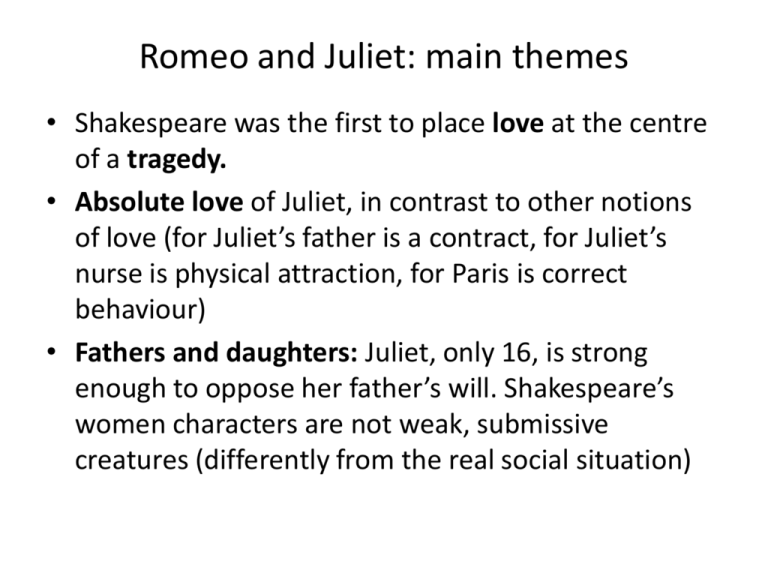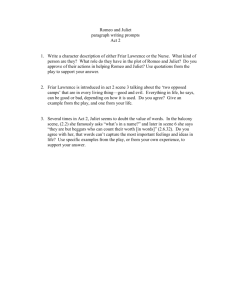Juliet's reflection upon language - Libero
advertisement

Romeo and Juliet: main themes • Shakespeare was the first to place love at the centre of a tragedy. • Absolute love of Juliet, in contrast to other notions of love (for Juliet’s father is a contract, for Juliet’s nurse is physical attraction, for Paris is correct behaviour) • Fathers and daughters: Juliet, only 16, is strong enough to oppose her father’s will. Shakespeare’s women characters are not weak, submissive creatures (differently from the real social situation) • Lack of knowledge, or bad communication leads to the tragic final destruction • Destiny vs free will: characters are free to choose, but this will lead to their death • Appearance vs reality: tragedy comes from believing in appearance. • Juliet’s reflection upon language: words are just a convention; they do not correspond to the essence of things. Extract on pages 65-66 • Ll 1-24: Romeo’s monologue: very poetic language. He describes Juliet using a lot of comparisons (metaphors and rhetorical exaggerations), typical of courtly love tradition (Juliet is compared to the sun, then her eyes to two stars…). Juliet is idealized but at the same time she is the object of sexual desire (ll 78). • Ll 26-33: Romeo’s aside: Juliet is compared to a bright angel. • Ll 34-50: Juliet’s monologue: reflection on the values of names. • Ll 51-81 dialogue: Juliet’s pragmatic reflections in contrast to Romeo’s poetic language and rhetorical exaggerations. • Romeo and Juliet’s monologues are written in blank verse = unrhymed iambic pentameter (each line is made of 5 stressed and 5 unstressed syllables) The sonnet: the most popular poetic form in the Renaissance • Derived from Dante and Petrarch • Main themes: love, friendship, beauty, time, the power of poetry to immortalize the beloved, to freeze a moment. • Paradox of the poet’s desire: he desires a lady but also hopes that she will remain unreachable. She is idealised and, therefore, perfect. • Differences between Petrarchan and Elisabethan sonnet ( see page 94) The metaphysical poets • They used elaborate philosophical metaphors, called conceits. They linked science to feelings (ex: John Donne’s comparisons of two lovers to two legs of a compass) Shakespeare’s sonnets (154) • To the young man ( the “fair youth”), his patron, probably the Earl of Southampton. • Main themes: love,friendship, beauty, time, power of poetry. The poet encourages the man to get married and procreate, so that his beauty can be passed on to his children. He also believes that the man’s beauty can be preserved in his poetry. Spiritual love • To the dark lady: passionate love • They reject the conventions of courtly love: the woman is not idealised but is a real, flesh-and-blood woman. • The dark lady is fascinating because she’s unique and natural (“beauty is in the eye of the beholder”). Henry Fuseli (1741-1825), Swiss artist. He travelled a lot in Germany, Italy and finally settled in Britain. Many of his works are inspired by Shakespeare. Here: Romeo at Juliet’s Deathbed, 1809 Hamlet and the ghost The nightmare







